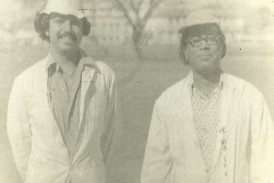Umpiring
Gulu Ezekiel |
How is it that when everyone at the ground – spectators, players, the three other umpires and the Match Referee as well as millions watching on TV – can see clear as day that a batsman has edged a delivery and is caught, but the man in the spotlight, the bowler’s end umpire, can miss the sight and sound of the edge and turn down the appeal even though he has the best view in the house?
Twice this thought has crossed my mind, the second time on the third day of the first “Ashes” Test match at Trent Bridge last month when Aleem Dar reprieved England’s Stuart Broad after he was “caught” at first slip and going further back, in January 2008 at Sydney when Steve Bucknor gave Australia’s Andrew Symonds not out after he clearly edged one from Ishant Sharma to the wicket-keeper.
It was Bucknor’s blunder that turned the Test and the series – Symonds went onto a match-winning century after the early reprieve – and led to all the bad blood between the two teams that nearly saw the remainder of the tour cancelled.
Following pressure from the BCCI, not only was Bucknor dumped from the next Test match, but the ICC also introduced the Decision Review System (DRS) to avoid such howlers.
Things have gotten more complicated since then with the use of various hi-tech gadgets, and also the restriction on the number of DRS appeals a side can make – this is what undid Australia at Trent Bridge – as also the BCCI’s refusal among all Test playing nations to allow the use of the DRS in bilateral series.
There has been some outrage in the Australian media over Broad’s refusal to “walk” which is ironic given the old saying that the only time an Australian cricketer walks is when he cannot find a taxi. And one does not recall the same sense of outrage when Symonds frankly admitted to the press at the end of the day in that infamous Sydney Test that he knew he had edged the ball.
Both incidents produced a sense of deja vu in me thanks to an incident going back nearly 40 years which I can still visualize in my mind’s eye as if it happened yesterday.
Despite my passion for cricket from my youth, my failure to make it as a player led me to try my hand first at umpiring and later on, journalism.
It was during my schooling in the 70s at St. Thomas’ Boys’ School, Kidderpore (Calcutta)- one of the top sports schools in the city back then – that I decided to seriously study the laws of the game and stand as an umpire in friendly matches (the Cricket Association of Bengal “official” matches always had senior qualified umpires).
Later on moving to Madras, I undertook an umpiring course in 1981 run by the Test umpire Mohammad Ghouse at the Tamil Nadu Cricket Association.
Back then in “friendlies” a player who was not in the XII would be pressed into reluctant service in what was considered a form of punishment, slightly lower down on the scale from scoring. And of course young umpires would think nothing of being blatantly biased, apart from having a rudimentary knowledge of the laws.
I thoroughly enjoyed my time out in the middle even if it was without a bat and ball in hand. Things would become a bit tricky when my elder brother would be batting or bowling. On one occasion which I still clearly recall I turned down a plumb lbw appeal from him – sorry bro!
Ironically, that cemented my reputation on the cricket circuit and rival schools would insist I stand in matches when they came to STS.
So why the deja vu? It was in a match against a local club (not school) in which the top batsman was a former student, a “grown-up” (meaning, early 20s) with a reputation for being a toughie in the locality that I made the worst call of my short umpiring career.
The edge was so clear it practically reverberated round the ground and spectators leapt up in appeal as did the bowler and the entire fielding side. It was his first ball and his wicket was vital.
As I was about to raise the dreaded finger, the batsman stared down the wicket at me and I suffered a brain freeze and hand freeze. He went on to score a match winning half century but at the end of the match the bowler came up to me and gave me a pat on the back. I guess I was looking pretty miserable. I still the recall the bowler’s name too!
The memory has stayed with me all these years. I just wonder if Bucknor and Dar too will be haunted for years by their blunders.
The third edition of the writer’s book, Captain Cool: The MS Dhoni Story (Westland) is due for release shortly







Leave a comment